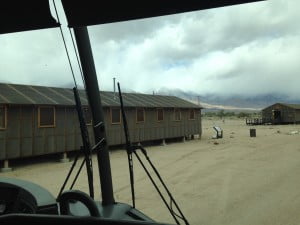“In Times of War.” A reflection by David Chávez.
Watashi wa Manzanar! I am Manzanar. These words were proclaimed by Dr. Satsuki Ina and greeted with a vocal and visual response as volunteers held up pre-made signs with the same slogan drawn with bold black markers on florescent poster board. This coordinated effort by the organizers of the Manzanar Committee was meant to evoke the urgency of collective memory for all those in attendance of the 46th annual pilgrimage to the former Federal Japanese concentration camp. Standing there on the dusty valley floor, hearing each of the speakers share the stories of their parents or themselves as incarcerated children and young adults, I wondered if this would be possible in other sites of detention? In a state which holds over 200,000 people in federal, state, county, and private cages, could they formerly incarcerated and their family’s hold space in relation to those at Manazar that day?
As someone who made this pilgrimage for the first time, it felt hauntingly familiar. Driving for hours, passing through what seems like endless desert-scapes, seeing buildings with western motifs beckoning to a past that never really was. The pilgrimage reminded me of traveling to visit my brother in Centinela State Prison just outside of the rural border town of El Centro. Both sites meant to be hidden in the rural landscape. Both forcing loved ones to make the journey which simultaneously conjures up the pain of incarceration and the joy of a reunited family. Although my emotional and physical connections to the pilgrimage as site of human warehousing manifested there, it was not lost on me the particularity of Manzanar. How those speaking at the podium and those with familial connections to the camp had been forcibly removed from their homes as part of Executive Order 9066. How they were forced to prove their allegiance to the State by relinquishing their freedom of movement. During a time of war overseas the war too came home with federal troops forcing Japanese residents on the West coast into camps and suspended citizenship until the end of World War II or deporting those who refused. That the incarceration at Manzanar and ten other sites was part of the longer history of white supremacy and anti-Japanese laws and violences committed by the State. How could our country incarcerate law-abiding citizens?
The atmosphere of the pilgrimage was very much in relation to the reclamation of citizenship rights. Nearly every speaker evoked this, denouncing the federal government’s use of forced detention to law abiding citizens. This relation to citizenship obscures my ability to truly say that I am Manzanar. For my brother and the 2.3 Million people currently incarcerated and the many more millions with living outside with felony conviction, their criminalization and detention is intimately tied to their evisceration of citizenship. Civil death by the courts continues to mark those targeted by the War on Drugs, War on Gangs, War on Terror, War ad nauseam.
While I have a strong connection to Manzanar, myself, my brother, and the masses of formerly incarcerated are not completely Manzanar. Not yet. The pilgrimage demonstrated to me the promise of a future where those released from sites of detention and their families can converge and reclaim their humanity. A future where we can connect as people gather and say “I am Pelican Bay” or “I am Men’s Central Jail.” Where instead of denouncing how the government could have done such atrocities to its citizens, we would denounce the realities of the Prison Industrial Complex.


